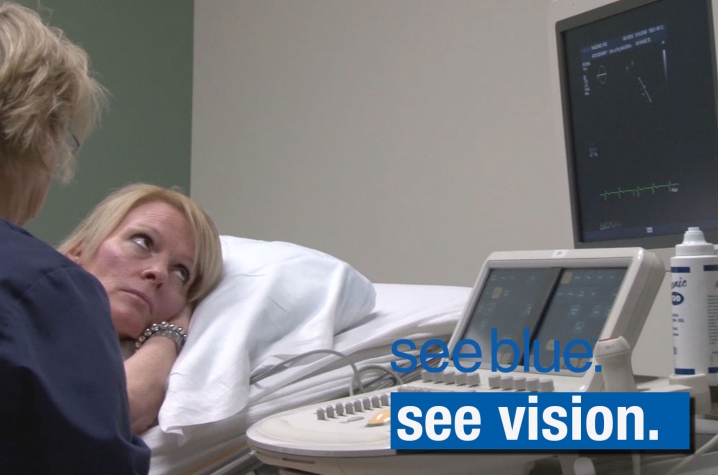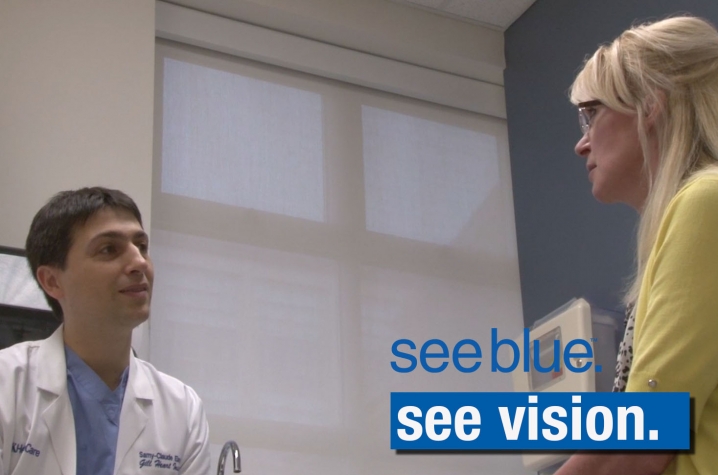High-Risk Heart Procedure Allows Lexington Mother to Return to Active Lifestyle
LEXINGTON, Ky. (June 27, 2014) -- Dr. Samy-Claude Elayi loves doing victory dances.
"It is a real blessing to wake up and enjoy doing a job that I am so passionate about,” said the physician-electrophysiologist at UK HealthCare's Gill Heart Institute. “I live for those magic moments where I make a difference in my patients' lives.”
Perhaps the most vivid example of his "magic moments" involves a woman named Rae Wagoner.
A petite blonde with a wistful smile, Wagoner always made being fit and healthy a priority. The 44-year-old former high school gymnast worked out at a gym at least three days a week and ran on the "off" days. She often played tennis with her college-age son as well. So, when she started having difficulty keeping up her normal pace, Wagoner knew that something was not quite right.
"In just six months, I went from 'what's wrong with me?' to being barely able to walk from my bedroom to the kitchen," Wagoner said. "I was so out of steam that I couldn't work, watch Sawyer (my son) play football or baseball games, or go to any of my extended family gatherings. I was essentially housebound."
Wagoner began going from one doctor to the next, looking for explanations for her continued weight loss, breathlessness, and muscle atrophy. Each appointment left her feeling disappointed and confused. "I began to think I was losing it," she said. "It's so scary when your body does things that you can't control and I didn't feel as if anyone was taking my symptoms seriously." One doctor even referred her to a psychiatrist to help her improve her coping skills.
Ultimately, repeated fainting spells brought her to a local hospital emergency room. An EKG revealed abnormalities, and she was referred to the Gill Heart Institute. Cardiologist Dr. Craig Chasen and Dr. Elayi teamed to complete her workup.
"We used a portable device called a Holter Monitor to record Rae's heartbeats over a 24-hour period," Elayi said. "It turns out she had a pretty serious V-tach."
V-tach or ventricular tachycardia, describes a condition where the electrical activity that controls the rhythm of a beating heart goes haywire, disrupting the normal heart contractions that pump blood throughout the body. Most people experience an occasional extra beat, but extreme, persistent cases create dyssynchrony of the contractions and exhaust the heart. And Rae's case was extreme.
"Forty percent of Rae's beats were abnormal," Elayi said. "One measure of her heart health -- how much blood is pumped out of the heart in a single beat -- was about half of normal."
Elayi put Rae on medications that usually resolve an irregular heartbeat, but they were ineffective. "We brought her back in pretty quickly, and when I saw her I was extremely concerned. She was visibly blue."
Wagoner was prepped immediately for surgery. Elayi and his team -- partner electrophysiologist Dr. Gustavo Morales and interventionalist Dr. John C. Gurley -- were using a minimally invasive procedure to go hunting for the nerve pathways destroying her heart.
Guiding a catheter up through Wagoner's femoral artery, Elayi and his team began exploring the interior chambers of her heart. They found nothing wrong. "It was really frustrating," Elayi remembers.
The next step was to explore the outside of Wagoner’s heart muscle, also known as the epicardium, which requires insertion of the catheter through the chest just below the ribs.
Because of its length and complexity, this high-risk procedure is usually done during a second visit to the cath lab. But Wagoner didn't have time to spare, so the team moved forward on the same day.
"When you're exploring around the outside of the heart, you have to be exactly on target to achieve success without injuring the coronary artery," said Elayi. "That level of precision requires a high level of expertise, and only very large medical centers are equipped to handle these complex cases."
Cue victory dance number one. Dr. Elayi found the rogue heart cells causing Wagoner's dyssynchrony and ablated -- or destroyed -- them.
“I’ll never forget when her heart went back into normal rhythm,” said Elayi. "There's that magic moment."
Victory dance number two came after Wagoner woke up from her procedure and continued to stay in normal rhythm. And since these cells typically do not regenerate, she should not have this problem again.
"I believe that it if it weren’t for Dr. Elayi I wouldn’t have come out of it at all. I have more and more energy every day," Wagoner said. She's running again and counting the days until she can return to the tennis court.
“How I feel now is the difference between night and day."






